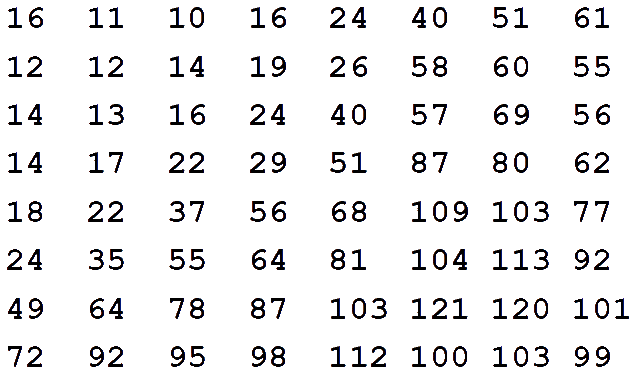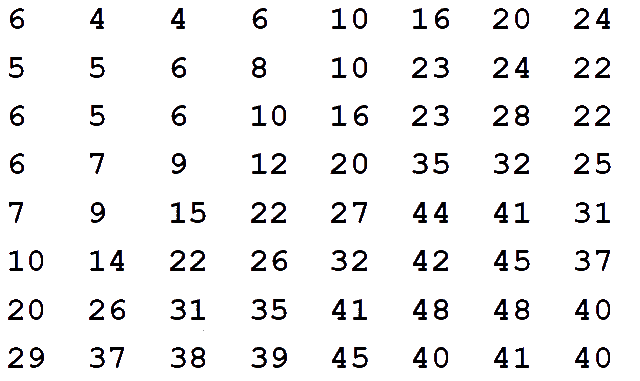Doug Kerr
Well-known member
We recognize that when using the JPEG scheme for compression of image data, we often have the opportunity to set what we can speak of (imprecisely) as the "compression level".
Sometimes (as in a typical digital camera) we have only two of three choices, often with names ("normal", "fine", "superfine").
In image manipulation software, we are often able to set the desired compression level numerically, perhaps with an index that runs from 1-12 and sometimes one that runs from 0-100.
Does such an index set a clearly-defined parameter of the compression process?
Well, yes and no.
First let us note that there are at least two wholly-different aspects of the overall JPEG compression process that we can vary.
Chroma subsampling pattern
We do not necessarily store the definition of the pixel chroma (which, in a certain way, defines the hue and saturation of the pixel's color) separately for each pixel. We may store a pair of chroma values for each pixel, or for only one out of each two pixels, or for only one out of each four pixels. This of course influences the amount of data in the file for chroma information (a significant influence on file size), and as a trade-off influences the resolution of chromaticity information in the reconstructed image.
Quantization tables
Quantization refers to taking information known to a certain precision and restating it to a lesser precision. ("Rounding" is a familiar example).
Simplistically, the more "coarsely" we quantize a certain body of data, the fewer bits are needed to represent it.
In JPEG, the luma and chroma information (derived from the RGB representation of each pixel's color) is represented in a scheme that is called the discrete cosine transform (DCT), somewhat like using the Fourier transform of an electrical signal to represent it.
The DCT coefficients (initially reckoned to a fairly high precision) are then quantized (so they are represented in fewer bits). The quantizing "coarseness" varies over the coefficients representing different spatial frequencies in the image, which takes into account the perceptual properties of the eye.
Thus, there is a table that tells, for each combination of vertical and horizontal frequency, how the DCT coefficient for that frequency combination is to be quantized (as if that table told, for each frequency pair, to how many significant figures the coefficient will be stated).
Thus, to quantize "more finely" or "more closely" overall, we would use a different table.
Not exactly. For one thing, the designer of the JPEG encoder is free to use such designs of quantizing tables as he finds suitable. This does not baffle the receiving decoder, since the details of both encoding tables used to encode an image are carried in the JPEG file "header", and the way they are to be "worked" is standardized.
But in fact there is a "suggested" repertoire given by an industry group (which in fact publishes a library of routines that can be used to build a JPEG encoder.
And the way that works is that there are "model" tables that can then be scaled up or down (to be "more coarse" of "more fine" by an algorithm.
The parameter for this scaling is related to a "quality index" which runs from 0-100, 100 leading to the "finest" quantization that is possible given various aspect of the system structure).
So if in fact the JPEG encoder used in a particular application follows this "suggested" quantization table building doctrine (which I understand few serious encoders do), then the program may offer the user a "JPEG quality setting" control, whose setting will then lead to a specific pair of quantization tables, and thus a specific (standard) result in terms of compression.
And of course, if the application uses it own quantization table building scheme, it may offer what looks like the same user opportunity: to set the "quality", perhaps on a scale of 0-100. But the implications of a certain value may not be the same as for another application. (Still, since the "result" can't really be very well quantified anyway, there may not be much of a difference that we can tell.)
Now does this mean that in such an application there are 101 different pairs of quantizing tables that might be used? Not really. The entries in the tables are small integers, so we cannot scale the tables "that finely". What is often done that the user-input range of 0-100 (if that's the way the user interface works) is divided into perhaps 10-12 ranges, and for each range a certain value of the "scaling parameter" is used.
So if the user selects a quality of 71, or 73, the result may be exactly the same.
In other cases, the user is only able to select a "quality" from a list, perhaps 0-10-20-30-40 etc.
Back to subsampling
But the subsampling pattern is also an aspect of the overall compression scheme, and its result. How is that controlled?
In some applications, the user just sets that.
In some applications, the same pattern is always used.
In some applications, the pattern that is used is preordained for each of two or three ranges of the user-set "quality".
Best regards,
Doug
Sometimes (as in a typical digital camera) we have only two of three choices, often with names ("normal", "fine", "superfine").
In image manipulation software, we are often able to set the desired compression level numerically, perhaps with an index that runs from 1-12 and sometimes one that runs from 0-100.
Does such an index set a clearly-defined parameter of the compression process?
Well, yes and no.
First let us note that there are at least two wholly-different aspects of the overall JPEG compression process that we can vary.
Chroma subsampling pattern
We do not necessarily store the definition of the pixel chroma (which, in a certain way, defines the hue and saturation of the pixel's color) separately for each pixel. We may store a pair of chroma values for each pixel, or for only one out of each two pixels, or for only one out of each four pixels. This of course influences the amount of data in the file for chroma information (a significant influence on file size), and as a trade-off influences the resolution of chromaticity information in the reconstructed image.
Quantization tables
Quantization refers to taking information known to a certain precision and restating it to a lesser precision. ("Rounding" is a familiar example).
Simplistically, the more "coarsely" we quantize a certain body of data, the fewer bits are needed to represent it.
In JPEG, the luma and chroma information (derived from the RGB representation of each pixel's color) is represented in a scheme that is called the discrete cosine transform (DCT), somewhat like using the Fourier transform of an electrical signal to represent it.
The DCT coefficients (initially reckoned to a fairly high precision) are then quantized (so they are represented in fewer bits). The quantizing "coarseness" varies over the coefficients representing different spatial frequencies in the image, which takes into account the perceptual properties of the eye.
Thus, there is a table that tells, for each combination of vertical and horizontal frequency, how the DCT coefficient for that frequency combination is to be quantized (as if that table told, for each frequency pair, to how many significant figures the coefficient will be stated).
Thus, to quantize "more finely" or "more closely" overall, we would use a different table.
By the way, there is a separate table for the luma and chroma data.
If there a standard "repertoire" of quantizing tables, running from "very fine" to "very coarse" from which we choose when encoding, depending on the compression level; chosen by the user?Not exactly. For one thing, the designer of the JPEG encoder is free to use such designs of quantizing tables as he finds suitable. This does not baffle the receiving decoder, since the details of both encoding tables used to encode an image are carried in the JPEG file "header", and the way they are to be "worked" is standardized.
But in fact there is a "suggested" repertoire given by an industry group (which in fact publishes a library of routines that can be used to build a JPEG encoder.
And the way that works is that there are "model" tables that can then be scaled up or down (to be "more coarse" of "more fine" by an algorithm.
The parameter for this scaling is related to a "quality index" which runs from 0-100, 100 leading to the "finest" quantization that is possible given various aspect of the system structure).
So if in fact the JPEG encoder used in a particular application follows this "suggested" quantization table building doctrine (which I understand few serious encoders do), then the program may offer the user a "JPEG quality setting" control, whose setting will then lead to a specific pair of quantization tables, and thus a specific (standard) result in terms of compression.
And of course, if the application uses it own quantization table building scheme, it may offer what looks like the same user opportunity: to set the "quality", perhaps on a scale of 0-100. But the implications of a certain value may not be the same as for another application. (Still, since the "result" can't really be very well quantified anyway, there may not be much of a difference that we can tell.)
Now does this mean that in such an application there are 101 different pairs of quantizing tables that might be used? Not really. The entries in the tables are small integers, so we cannot scale the tables "that finely". What is often done that the user-input range of 0-100 (if that's the way the user interface works) is divided into perhaps 10-12 ranges, and for each range a certain value of the "scaling parameter" is used.
So if the user selects a quality of 71, or 73, the result may be exactly the same.
In other cases, the user is only able to select a "quality" from a list, perhaps 0-10-20-30-40 etc.
Back to subsampling
But the subsampling pattern is also an aspect of the overall compression scheme, and its result. How is that controlled?
In some applications, the user just sets that.
My favorite image editor, Picture Publisher does that. Sadly, it bungles the rather peculiar notation by which the various subsampling pattern are often stated.
In some applications, the same pattern is always used.
In some applications, the pattern that is used is preordained for each of two or three ranges of the user-set "quality".
Best regards,
Doug


